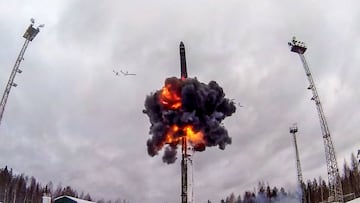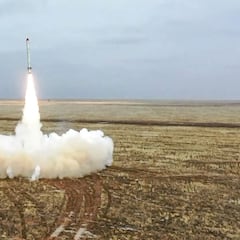Does the US have a nuclear defense system?
Vladimir Putin has many bones to pick with the US, but one in particular he says soured his relationship with the US. An ICBM missile defense system.

Mutually Assured Destruction, or MAD, is one of the reasons neither the US nor the Soviet Union used nuclear weapons against each during the Cold War, but they came close. The theory goes that if one nation strikes first, they themselves would be annihilated by the sheer number of nuclear weapons possessed by the other.
One of the cornerstones to keeping the peace was a treaty signed in 1972, the Antiballistic Missile Treaty. Prior to its signing both nations had been working on antimissile defenses. Worried about a potential nuclear threat coming from Iran, former President George W Bush pulled out of the agreement in 2001.
Also see:
- Theories about the mysterious 'Z' on Russian tanks in Ukraine
- Can Ukraine join EU and how long would it take?
- How much damage does a nuclear weapon do?
- How Russia-Ukraine war fits into Biden's State of the Union
- Nuclear arsenals around the world
The US missile defense shield
The United States embarked on a program to erect a shield that could stop an incoming intercontinental ballistic missile (ICBM). The US tried to assure their Russian counterparts that the defense system would be ineffective at stopping their missiles. The radar systems and interceptors were directed at Iran, and then later North Korea when it joined the limited club of nations with nuclear weapons.
The US will sometime this year activate the Aegis Ashore system that has been installed in Poland which is part of the third and final phase of the European part of the shield. Another was installed in Romania and has been operational since 2016. Russia has repeatedly complained about the US installing these advanced systems and has even threatened to place nuclear missiles in Kaliningrad, a small part of Russia on the Baltic coast wedged between Poland and Latvia but separate from the Russian mainland.
How effective is the US nuclear defense system?
The Aegis uses powerful radar and computers in an integrated naval combat system that can be used to track incoming threats as well as guide weapons to destroy enemy targets. The system has been upgraded to deal with ballistic missiles as well. The Aegis Ashore is simple a ground-based version.
The US missile shield is designed to launch a missile which should impact an ICBM warhead on reentry. So far the US has conducted three successful tests but there are questions about its true ability to stop even a limited attack with ICBMs.
Related stories
The American Physical Society examined countering a hypothetical North Korean strike using current missile defense systems. The study found that few of the main challenges have been solved. Additionally, many of the hard problems are likely to remain unsolved perhaps beyond the 15-year time horizon considered.
Even if the system isn’t one hundred percent effective within 15 years it will still change the calculation of how America’s nuclear rivals plan their own arsenals and battle contingencies. If such a system were to be effective, it could technically give the US, or whoever possessed a similar system, the capacity to strike first and avoid the consequences of a retaliatory strike. The Doomsday Clock is at 100 seconds to midnight.


